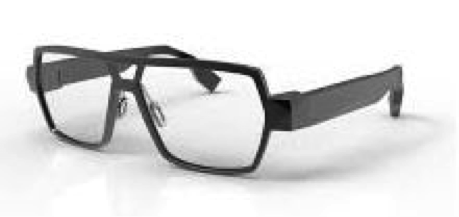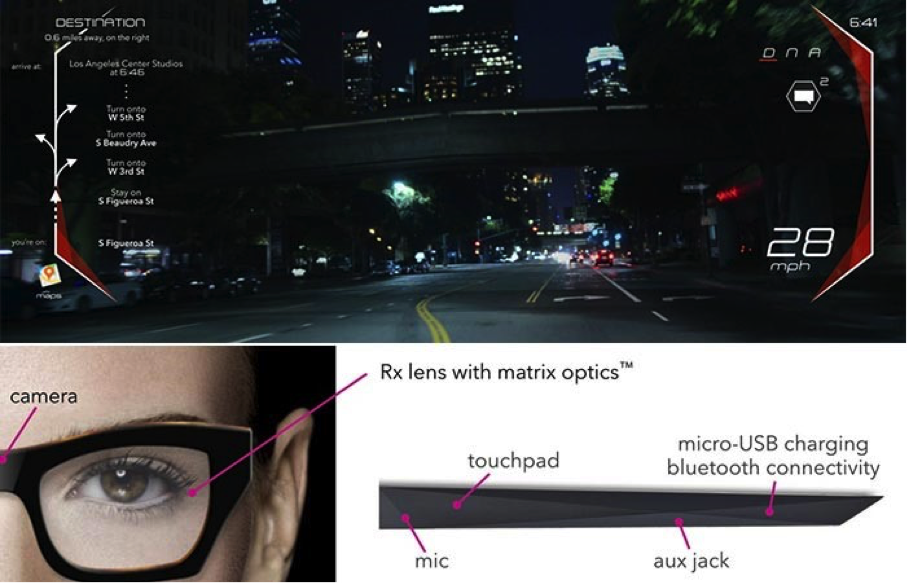|
AR/VR
Augmented Reality Device Looks Just Like Your Glasses March 06, 2017 Laforge Optical Inc. is developing a product line of augmented reality smart glasses. The glasses overlay video content derived from the wearer’s iOS or Android smartphone as images in the wearer’s line of sight. Preeminent among the many features of the so-called Shima glasses is their appearance: they look very much like an ordinary pair of glasses as shown in the image below. Figure 1 Shima AR Glasses Source: Company
Few details of the glasses design are publically available. But it is clear that the glasses combine lenses and coatings with projection and a prism embedded in the eyeglass lens to display the imagery. The screen is located in the side frame of the eyewear. The small, virtual so-called “Phantom Display” image is projected and focused onto the wearer’s retina. The image appears to float in front of the wearer and stays in focus regardless of the wearer’s direction of view. When not actively in use, the Phantom Display transitions into a sleep mode and becomes almost invisible to the wearer. The company plans to roll out the product in three phases. The first phase is called Alpha, the second Beta and the third Beta Bold. The Alpha and Beta glasses will present an image with WQVGA resolution to only the right eye. (WQVGA or Wide QVGA is any display resolution having the same height in pixels as QVGA, but wider. Typical examples are 240×400, 240×432 and 240×480.) The Beta Bold will have two displays presenting images to each of the wearer’s eyes. Shima comes equipped with USB 2.0 connection to enable data transfers and USB type-C for charging. Under normal use, Shima will last 18 hours on a single charge and can recharge in about 30 minutes. The Shima Glasses are powered by 180MHz ARM Cortex-M4 processor and include 32MB NOR Flash and 16MB PSRAM. The glasses use a Linux-based operating system called ghOSt v0.1.0. Storage in the Alpha version is 1GB SLC NAND, in the Beta it is 4GB and in Beta Bold it is 8GB. The glasses also have three sensors to detect three-axis motion: a gyroscope, accelerometer and magnetometer. In addition, the glasses include a temperature sensor and an ambient light sensor. An aux jack is included and allows the wearer to listen to music through their headphones. The Beta Bold model includes a microphone that captures sound for recording videos and use in phone calls and a camera capable of taking 3 MP pictures and recording 30-second bursts of video at 720P. Part of the rationale of the Shima glasses is that they allow the wearer to interact with their smartphone content without having the smartphone physically in their hand. The wearer can navigate through the interface and engage with widgets and notifications through the use of five tactile buttons found in the frames of the glasses. In addition, the Alpha and Beta models have a single touch pad also found on the frames. The Beta Bold model has two touchpads. The touchpads accept taps and multi-finger swipes. The glasses operate in three modes:
A screen capture of representative imagery projected on a night scene is illustrated in the top of the figure below. The bottom part of the figure is a sketch to the glasses frame indicating control points. Figure 2 Sample Shima Image Source: Company
Laforge Optical offers customers the option of having their prescription built into the lenses of the Shima glasses - at no extra cost. Some Alpha units are reported to have already shipped. Alpha version glasses ordered now at a price of $590 will ship during the second quarter this year. Orders placed now will get the Beta version for free. The Beta version is planned to ship later this year. Figure 3 Shima vs. Google Glass Source: Company
|
Vertical Divider
|
|
Contact Us
|
Barry Young
|



